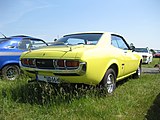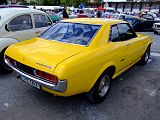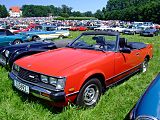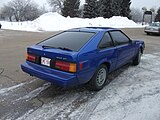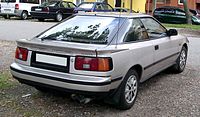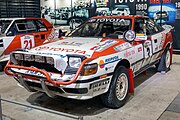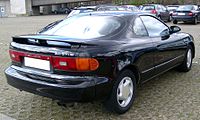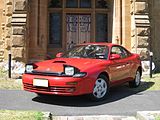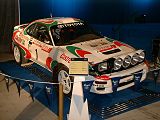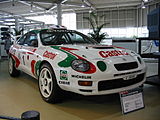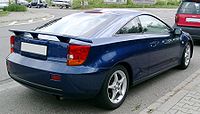Toyota Celica
| Toyota Celica | |
|---|---|
| Production period: | 1970-2005 |
| Class : | Sports car |
| Body versions : | Coupé , station wagon coupé , convertible |
| Successor: | Toyota GT86 |
Toyota Celica was the name of a coupé series by the Japanese car manufacturer Toyota , which was produced in seven model series from autumn 1970 to summer 2005 and which also formed the basis of the Toyota Supra model series, which was independent from the beginning of 1986 .
The Coupé Celica, introduced in Germany in November 1971, was based on the Toyota Carina limousine series that already existed at the time, particularly with regard to the vehicle frame, engine and technology . The concept of a two-door, four-seater sports coupé with an in- line four-cylinder engine has been retained through all generations . The greatest significant change to the vehicle concept took place in 1986 when the drive was changed from rear-wheel drive to front-wheel drive and a version with all-wheel drive was added in 1988 .
All series were produced in Toyota's Japanese plant in Tahara, Aichi . The name Celica is derived from the Spanish word for "heavenly" (celestial) .
Celica (TA22, 1970–1975; abroad also RA2)
| 1st generation (data: Japanese versions) |
|
|---|---|
|
Toyota Celica ST (1970-1975) |
|
| Production period: | 1970-1975 |
| Engines: |
Petrol engines : 1.4-2.0 liters (63-79 kW) |
| Length: | 4215-4235 mm |
| Width: | 1610-1620 mm |
| Height: | 1280-1310 mm |
| Wheelbase : | 2495 mm |
| Empty weight : | 940-1055 kg |
The first Celica was launched on the Japanese market in autumn 1970, and in Germany from autumn 1971.
The most common variant in Germany was the Coupé TA22 model designation "ST" with 63 kW (86 PS), equipped with a 1600 cm³ engine and double carburetor . The standard 5-speed gearbox was not part of the usual automotive standard in 1971. The "LT" model was also available with a single carburetor, which mobilized 58 kW (79 PS) with a 5-speed gearbox and 55 kW (75 PS) with a 3-speed automatic.
In 1972 the series was supplemented by the GT model, which had a 1600 cc engine with double carburetors and two overhead camshafts and developed 79 kW (107 hp).
- Engines (designation, displacement , fuel supply, valve control , engine supercharging )
- 1.6 l, 2T, carburetor , DOHC
- 1.6 l, 2T-B, double carburetor, OHV
- 1.6 l, 2T-G, two double flat-flow carburetors, DOHC
Abroad:
- 1.9 l, 8R, carburetor, HCCI
- 2.0 l, 18R, carburetor, SOHC
- 2.2 l, 20R, carburetor, SOHC
Celica (TA23 / TA28 / RA28, 1975-1977)
The major facelift of the first Celica in October 1975 brought a wheelbase extended from 2425 mm to 2495 mm, which only benefited the front end. The reason for this was the installation of larger engines for the US market. The visual differences between the TA23 and the previous model (TA22) were vertical parking lights, new grill designs and more subtle hoods on the bonnet. The rear section with the split lights introduced in model year 1973 and the tank filler neck moved from the impact area to the C-pillar on the driver's side remained unchanged.
The Celica series was supplemented by the Liftback, which was introduced in Japan in 1973 and whose design was based on the Ford Mustang Fastback. These versions with a large tailgate (TA / RA28) were equipped with the well-known 63 kW (86 PS) 2T-B engine, as well as a newly developed 1988 cm³ DOHC engine (18R-G), which produced 88 kW (120 PS) generated. The so-called 2000GT was supposed to keep high-horsepower competitors like Ford Capri 3.0, Opel Manta GT / E and Lancia Beta HPE 2000 in check.
Production of the first generation ended in December 1977. Toyota produced a total of 1,210,951 copies in seven years.
Celica (TA4 / RA4, 1978-1982)
In April 1978 the second generation of the sports car appeared, which was initially equipped with double round headlights.
At the beginning of 1980 a facelift was carried out in which the front of the Celica (as the most striking change) was converted to rectangular double headlights.
The technology remained almost unaffected. At the same time, the Celica Liftback XT variant with the Toyota Cressida engine and an output of 77 kW (105 PS) was added. The Cabriolet and Targa / Landaulet versions of the Coupé were subsequently converted for the German market by the Tropic company.
- 1.6 l, 2T
- 1.6 l, 2T-B, double carburetor
- 1.6 l, 2T-G, two double flat-stream carburetors, DOHC
- 2.0 l, 18R,
- 2.0 l, 18R-G, two double flat-flow carburetors, DOHC
In April 1978, a model named Celica XX Supra was presented in Japan, in two versions with 92 kW (125 PS) and 103 kW (140 PS), which was later also available in the USA and the origin of the later, independent model Toyota Supra depicted.
Celica (TA6, 1982-1985)
The third generation was introduced in February 1982. Her headlights folded back so that the glass part remained visible. Equipment variants available in Germany were ST, XT, GT and Celica Supra . The buyer could choose between the two-door coupé or the three-door fastback coupé (liftback).
In November 1983, numerous details were changed with the first facelift , with the now fully retractable pop-up headlights being particularly striking. In addition, the GT variant received the 4A-GE engine, which was not previously available. This range of models was the last of the rear-wheel drive Celica.
The following variants of the TA 6 were available in Germany (1982–1985):
- ST (1982–1985, model TA60): engine 2T-B, displacement 1588 cm³, 63 kW (86 PS); Coupé, two-door
- ST (1982-1985, TA60): engine 2T-B, 1588 cc, 63 kW (86 hp); Fastback coupe, three-door
- 2.0GT (1982–1983, RA63): engine 18R-G, 1968 cc, 88 kW (120 PS); Coupé, two-door
- 2.0XT (1982–1985, RA61): engine 21R, 1972 cm³, 77 kW (105 PS); Fastback coupe, three-door
- Supra 2.8i (1982–1985, MA61): engine 5M-GE, 2763 cm³, 125 kW (170 PS); Fastback coupe, three-door
from 1983 the 2.0GT was replaced by:
- 1.6GT (1983–1985, AA63): engine 4A-GE, 1587 cc, 91 kW (124 hp); Coupé, two-door
Other equipment versions and engine variants were offered abroad.
Celica (T16, 1985-1989)
In September 1985, the fourth generation with front-wheel drive and transversely installed 103 kW (140 hp) four-cylinder engine was presented at the International Motor Show (IAA) in Frankfurt.
The 136 kW GT-Four with a displacement of two liters, a turbocharger and permanent all-wheel drive followed in early 1987 .
A year earlier, the model series Celica and Supra were separated by name and the top model Toyota Supra retained rear-wheel drive. The Japanese sister model was the Corona Coupé .
- 1.6 l, 4A-GE, injection,
- 2.0 l, 2S-E, injection, SOHC
- 2.0 l, 3S-FE, injection, SOHC
- 2.0 l, 3S-GE, injection, DOHC, 103 kW (140 PS with catalytic converter)
- 2.0 l, 3S-GE, injection, DOHC, 110 kW (150 PS without catalyst)
- 2.0 l, 3S-GTE , injection, DOHC, turbocharger, 136 kW (185 PS)
Celica (T18, 1989-1994)
| 5th generation | |
|---|---|
|
Toyota Celica (1989-1994) |
|
| Production period: | 1989-1994 |
| Body versions : | Kombicoupé , convertible |
| Engines: |
Petrol engines : 1.6–2.0 liters (77–153 kW) |
| Length: | 4409-4470 mm |
| Width: | 1689-1745 mm |
| Height: | 1280-1300 mm |
| Wheelbase : | 2525 mm |
| Empty weight : | 1150-1525 kg |
In October 1989, the fifth generation was presented again at the IAA, which attracted attention with its consistently aerodynamic design and distinctive pop-up headlights . With minor changes, it was sold as the Toyota 2000 VX in some markets .
Active Sports version from 1989 with the world's first computer-aided active suspension : Toyota Active Control Suspension . It is a complex, hydraulic active chassis with computer control. The cars no longer had conventional springs and stabilizers , but hydraulic dampers that were controlled by sensors that detected driving conditions such as cornering, acceleration and braking. The system worked perfectly and delivered a very controlled yet comfortable ride without side tilt of the body (Mercedes-Benz has introduced in 1999 a very similar chassis: Active Body Control ).
The new four-cylinder with 16 valves developed 77 kW (105 hp), the two-liter engine was expanded to 115 kW (156 hp).
In 1990 the all-wheel drive model turbo 4WD and in 1992 the special model Carlos Sainz with 150 kW or 153 kW 2.0 liter turbo engine came as a reminiscence of the Spanish driver's 1992 World Rally Championship on the Celica turbo 4WD .
- 1.6 l, 4A-FE, injection, DOHC, 1.6 ST-i, 77 kW (105 PS).
- 2.0 l, 3S-FE, injection, DOHC, Japanese SR, ZR.
- 2.0 l, 3S-GE Gen2, injection, DOHC, Japanese GT-R, Europe 2.0 GT-i 16, 115 kW (156 PS).
- 2.0 l, 3S-GTE Gen2, injection, DOHC, turbocharger, GT-Four / turbo All-trac / turbo 4WD, 150 kW (204 PS).
- 2.0 l, 3S-GTE Gen2, injection, DOHC, turbocharger, GT-Four RC / turbo 4WD Carlos Sainz Limited Edition, 153 kW (208 PS)
- 2.2L, 5S-FE, injection, DOHC, North America (GT, GT-S), Australia (SX).
Celica (T20, 1994-1999)
| 6th generation | |
|---|---|
|
Toyota Celica (1994-1999) |
|
| Production period: | 1994-1999 |
| Body versions : | Kombicoupé , convertible |
| Engines: |
Petrol engines : 1.8–2.2 liters (85–178 kW) |
| Length: | 4420 mm |
| Width: | 1750 mm |
| Height: | 1305 mm |
| Wheelbase : | 2535 mm |
| Empty weight : | 1155-1398 kg |
As early as November 1993, the sixth generation with the four distinctive round headlights was presented at the Tokyo Motor Show (sold in Japan and Russia with band headlights under the name Toyota Curren ).
In 1994 the engine consisted of a 1.8 liter engine with 85 kW (116 hp) and a 2.0 liter engine with 129 kW (175 hp). The GT-Four followed in 1995 with 178 kW (242 hp). The model series was equipped with ABS and a driver airbag as standard .
The Super Strut chassis, which was first offered in Europe in the Carina E GTi , was now also available as an option for the GT version of the Celica and was part of the standard equipment on the GT-Four.
In addition, a third-generation convertible based on the T20 was presented for the US market at the end of 1995 , some of which was also sold in Europe.
In April 1996 a facelift was carried out with detailed changes (2.0 GT only with 170 hp).
- 1.8 l, 7A-FE, injection, DOHC, 85 kW (116 PS)
- 2.0 l, 3S-GE, injection, DOHC, GT (Facelift), 125 kW (170 PS)
- 2.0 l, 3S-GE, injection, DOHC, GT, 129 kW (175 PS)
- 2.0 l, 3S-GTE , injection, DOHC, turbocharger, GT-Four, 178 kW (242 PS)
- 2.2 L, 5S-FE, injection, DOHC, 100 kW (136 hp) for North America and Australia
Celica (T23, 1999-2005)
| 7th generation | |
|---|---|
|
Toyota Celica (1999-2002) |
|
| Production period: | 1999-2005 |
| Body versions : | Combi coupe |
| Engines: |
Petrol engines : 1.8 liters (105–141 kW) |
| Length: | 4335 mm |
| Width: | 1735 mm |
| Height: | 1315 mm |
| Wheelbase : | 2600 mm |
| Empty weight : | 1150-1215 kg |
The seventh generation, designed in the Sharp Edge design, was presented in November 1999 with a 1.8-liter engine that developed 105 kW (143 hp) or 141 kW (192 hp), depending on the model. The 2 + 2-seater was offered in three model variants, as Celica 1.8 , Celica S and Celica TS.
In autumn 2002 the series received a slight facelift on the front and rear.
In July 2004 Toyota announced the discontinuation of the Celica (and MR2 ) at the end of the 2005 model year due to increasing competition and insufficient sales. Sales fell from 52,406 units in 2000 to 8,216 in November 2004.
In August 2005, Toyota stopped production of the Celica.
- Engines
- 1.8 l, 1ZZ-FE, 1794 cm³, 105 kW (143 PS), injection, DOHC, VVT-i
- 1.8 l, 2ZZ-GE, 1796 cm³, 141 kW (192 PS), injection, DOHC, VVTL-i
Motorsport
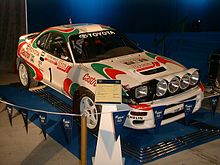
Based on the Celica, Toyota, headed by Cologne-based Toyota Team Europe , won the drivers' championship four times in the World Rally Championship with the ST165 and ST185 models in 1990 , 1992 , 1993 and 1994 . Didier Auriol , Juha Kankkunen , Carlos Sainz , Armin Schwarz and Björn Waldegård , who won four long-distance rallies, were among the most successful drivers of the Celica .
In 1994 the New Zealander Rod Millen won the Pikes Peak International Hill Climb with the 850 HP (625 kW) special conversion Celica Turbo "Pikes Peak" and set a course record of 10: 04.06 minutes, which was valid for 13 years.
literature
- Robert de la Rive Box: Toyota Celica - History and Model Development, Serag Verlag (CH), ISBN 3-908007-61-5
- Brian Long: Toyota Celica - 25Years of Development and Motorsport , Longford International (GB), ISBN 1-899154-02-7
Individual evidence
- ↑ Cars without a successor (Fig. 47) on Autobild.de (accessed on August 4, 2010)
- ↑ The new Celica is called GT 86
- ↑ Toyota Chassis (engl.)
- ↑ Toyota Super Strut Suspension System (Eng.)
- ↑ functioning and models with Super Strut suspension (Engl.)



